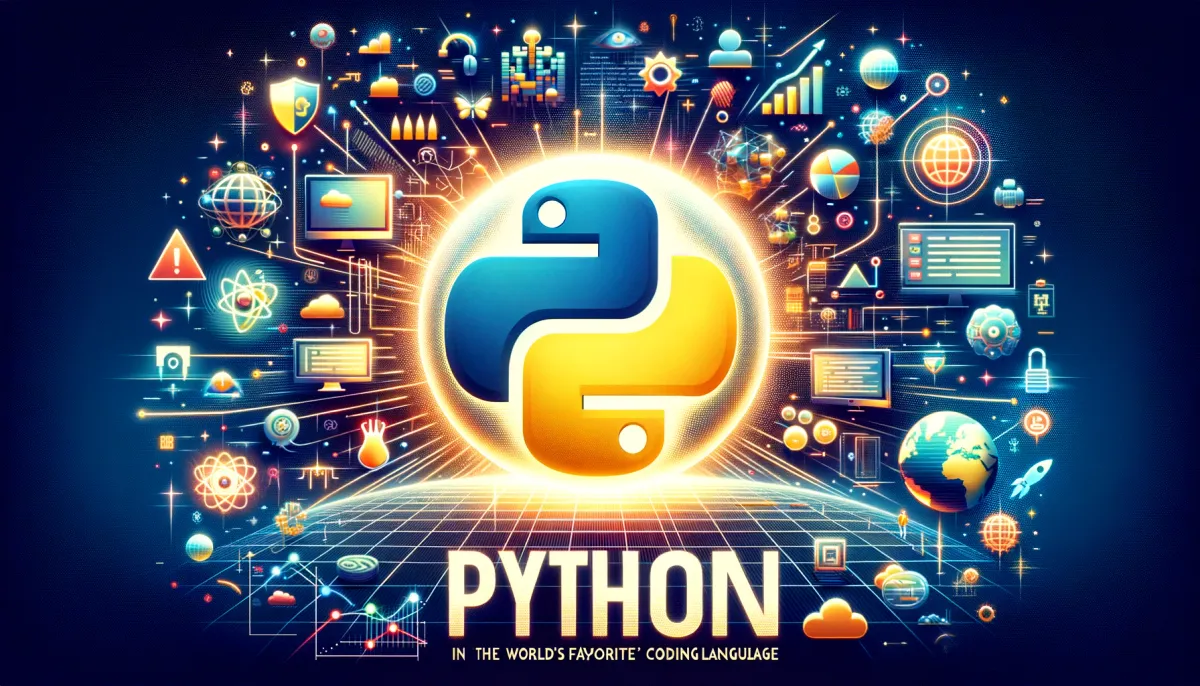The Power of Python: Exploring the Popularity and Versatility of the World’s Favorite Coding Language
Discover why Python has become a popular programming language. Learn about its simplicity, versatility, community support, and applications.

Why Python is a Programming Language Worth Discussing
Python is one of the most popular programming languages in the world. It has been around since the early 1990s and has gained immense popularity over the years.
Its popularity can be attributed to several reasons, including its versatility, ease of learning, and large community support. Python is worth discussing because it has become a go-to language for developers who want to create applications quickly and efficiently.
Its syntax is simple and readable, making it easy to learn even for beginners. Unlike other programming languages that use complex syntax and require lengthy lines of code, Python uses fewer lines of code, making it an attractive option for developers who value efficiency.
Python’s popularity can also be attributed to its extensive range of libraries. These libraries help developers speed up their development process by providing them with reusable code snippets that they can integrate into their projects.
With Python, you don’t need to reinvent the wheel every time you want to create something new; chances are there’s already a library out there that will do what you need. In addition to its simplicity and efficiency, Python has also gained popularity because of its versatility.
It can be used in a variety of applications from web development to data science. Its flexibility has made it a top choice among developers for creating everything from small scripts to large-scale enterprise applications.
Python’s popularity continues to grow year after year due to its simplicity, efficiency, versatility, and vast range of libraries. Whether you’re a beginner or an experienced developer looking for a reliable language with extensive community support – Python should be at the top of your list when considering which programming language to learn or use in your next project.
Easy to Learn and Use
Python has become an incredibly popular language for beginners because it is easy to learn and use. The simple syntax and readability make it accessible for those who are just starting out with programming.
Unlike other languages that require a lot of complex syntax or long lines of code, Python is written in a way that is easy to read and understand. The language’s sensitivity to whitespace also makes it easier for beginners to avoid syntax errors.
Indentation in Python code determines the structure of the program, which can help novices understand the logic behind their code more clearly. In addition, there are many online resources available for learning Python.
From video tutorials on YouTube to online courses on platforms like Udemy and Coursera, there are countless ways to learn the language at your own pace. Many online resources even offer interactive coding environments where users can practice their skills without having to download any software.
Overall, Python’s ease of use has made it a popular choice for both novice programmers and experienced developers looking for a more efficient way of coding. Its straightforward syntax allows even those with no programming experience to start writing code quickly while still providing enough complexity for advanced projects down the line.
Versatility: Python’s superpower
Python is often referred to as a “general-purpose” programming language because it can be used in various fields for different purposes. One of Python’s most significant strengths is its versatility – it can be used in scientific computing, web development, artificial intelligence, data analysis and visualization, and much more. This flexibility has made it a go-to language for many developers.
Python’s versatility is partly due to the numerous libraries and frameworks available in the language. The libraries are well-maintained collections of pre-written code that can be imported into a Python program to extend its functionality.
For instance, NumPy is a library for scientific computing with Python that provides support for arrays and matrices. Matplotlib, on the other hand, is a data visualization library that allows you to create charts and graphs from your data.
Python’s versatility extends beyond these standard libraries too: developers have created countless packages that you can use based on your specific needs. Whether you’re working on a project dealing with image processing or cryptography or finance or even gaming, there’s likely a package available that will make your life easier.
Examples of industries that use Python
Python’s flexibility has made it widely adopted across various industries. In astronomy, researchers use Python in analyzing astronomical data sets through modules like Astropy; scientists also use packages such as Scipy or Pandas for their experimental work. In finance and economics, Pyfolio enables portfolio optimization while Quantlib provides support for quantitative financial modeling.
Growth marketing teams use web scraping tools like Beautiful Soup along with Python scripts to gather information from social media platforms quickly. In web development circles too – Flask and Django are two of the most popular Python-based web frameworks out there today used by companies like DropBox and Instagram respectively; Tornado is another framework known for its high-performance capabilities.
There are many more examples we could explore here, but the point is that Python’s versatility has allowed it to become a widely-used language in so many industries. Its large and active community of contributors means there are always updates and new packages available, which keeps it relevant and ensures its continued growth in popularity.
Large Community Support
Python has an incredible community of developers who use and contribute to the language. The community is so vast that Python has become one of the most popular programming languages in the world. The community support is so great that any problem you encounter while using Python, chances are, someone else has already experienced it and found a solution.
Thus, a quick Google search can go a long way in finding solutions to common problems. The benefits of having such a large community supporting Python are many.
The most significant benefit is the availability of open-source libraries. Thousands of open-source libraries have been developed specifically for Python, making it easier to build complex applications without needing to start from scratch.
These libraries not only save time but also help with code reusability and improve overall code quality. Moreover, with such a vibrant community backing it up, Python will continue to evolve and improve over time.
Any bugs or issues discovered within the language will be addressed quickly by developers worldwide working together towards solving them. Being part of a massive global network of developers makes using Python an exciting experience for anyone interested in programming or software development.
Whether you are seeking help or want to contribute back through developing new modules or packages—there’s always someone eager to help out! It’s this kind of collaboration that makes Python stand out from other programming languages and explains why it’s been growing exponentially year after year!
Data Science Applications
Python is a powerful language that has become the go-to choice for data scientists and researchers. In fact, Python’s success is largely due to its ability to handle large datasets and perform complex data analysis tasks with ease. This makes it the perfect language for machine learning, artificial intelligence, and other forms of data science.
How Python is Used in Data Analysis
Data analysis is one of the most important applications of Python. With libraries like NumPy and Pandas, Python can handle massive datasets and perform complex mathematical operations with speed and efficiency.
For example, businesses use data analysis to make informed decisions about their products or services. They can use Python to analyze customer behavior, sales trends, and other key metrics to identify areas where they can improve their offerings.
Data analysts can also use Python for exploratory data analysis (EDA), which involves using statistical tools to summarize important aspects of a dataset. EDA helps analysts identify patterns in the data that may not be immediately obvious, allowing them to develop more accurate models.
How Python is Used in Machine Learning and Artificial Intelligence
Machine learning (ML) and artificial intelligence (AI) are two of the most popular applications of Python today. Thanks to libraries like TensorFlow and PyTorch, developers can build complex ML models with ease. In addition, PyBrain provides a comprehensive set of tools for building AI systems using neural networks.
This enables developers to create intelligent systems that can learn from experience. Python’s popularity in these applications stems from its simplicity and ease of use compared to other languages such as C++ or Java.
Popular Libraries for Data Science in Python
The most popular libraries used by Data Scientists are:
- NumPy: This is a library used for numerical computations. It provides array and matrix manipulation, linear algebra operations, Fourier transforms, and random number generation capabilities.
- Pandas: This is a library used for data manipulation and analysis. It provides data structures for efficiently storing large datasets and tools for filtering, grouping, and aggregating data.
- Matplotlib: This is a library used to create a wide range of static, animated, and interactive visualizations in Python. It has interfaces that are usable from command-line scripts, Python programs, or via Jupyter notebooks.
Python’s popularity in data science applications is due to its simplicity, versatility, and abundance of powerful libraries available. From exploratory data analysis to machine learning and artificial intelligence, Python has become an essential tool for researchers worldwide.
Web Development Applications Web development has grown immensely popular in recent years, and Python has been an instrumental player in making it accessible to a wider audience. Two of the most notable frameworks that Python is associated with are Django and Flask.
These frameworks have become some of the most popular solutions for creating web applications in Python. They allow developers to create complex applications quickly and easily.
Django is a high-level web framework that follows the model-view-controller (MVC) architectural pattern. It provides a large number of built-in features that make development faster and easier, such as an ORM, form handling, authentication system, admin panel, and more.
Django’s batteries-included approach means that developers can work with one cohesive platform to build complex apps from scratch. Flask is another popular framework that focuses on simplicity and minimalism while providing more freedom for developers to customize their projects as desired.
It provides only the essentials such as routing requests, creating cookies, or handling HTTP request/response cycles. Its minimalist nature makes it great for small projects where simplicity is key.
Advantages of using these frameworks There are many advantages of using Flask or Django when building web applications in Python:
– Speed: With these frameworks’ powerful features like built-in templates and pre-built libraries, it’s possible to create complex applications much faster than if you were coding everything from scratch. – Scalability: Both Django and Flask are scalable enough to accommodate growing traffic demands without any significant changes.
– MVC architecture: The Model-View-Controller (MVC) pattern used by both frameworks makes code organization much easier to manage as your project grows. – Community support: Both communities have active members who contribute back by creating plugins or writing tutorials making it easier for new users to get started.
– Security: Django comes packed with security features like CSRF protection, and SQL injection prevention mechanisms while Flask can work with third-party libraries easing things up even more. Choosing between Flask or Django is dependent on the project being developed.
Both frameworks have their pros and cons, but they have proven to be reliable and effective solutions for web development in Python. These web frameworks allow developers to create scalable, secure, and user-friendly apps quickly and efficiently, all while managing code effectively.
Conclusion
Recap on Why Python is Popular
Python has gained a lot of popularity in recent years and for good reason. Its simple syntax and readability make it easy to learn, and its versatility allows it to be used in a wide range of applications.
The large community support also means that developers have access to a vast number of libraries and resources. Python’s popularity in the data science industry cannot be overstated.
It offers a variety of libraries for data analysis, machine learning, and artificial intelligence, making it an ideal language for anyone interested in these fields. Additionally, Python is widely used in web development with frameworks like Django and Flask, which offer advantages such as rapid development time.
Final Thoughts on the Future of the Language
The future looks bright for Python. With ongoing developments such as Python 3.10, which promises improved performance, and new features like structural pattern matching, it’s clear that the language is continuing to evolve.
Additionally, the rise of new technologies like machine learning and artificial intelligence means that Python will likely continue to be an essential tool for developers working in these fields. Overall, there are many reasons why Python has become one of the most popular programming languages today.
Its simplicity makes it accessible to beginners while its versatility makes it useful for experienced developers as well. With ongoing support from its large community and exciting developments on the horizon, there’s no doubt that Python will continue to play an important role in software development for years to come.



